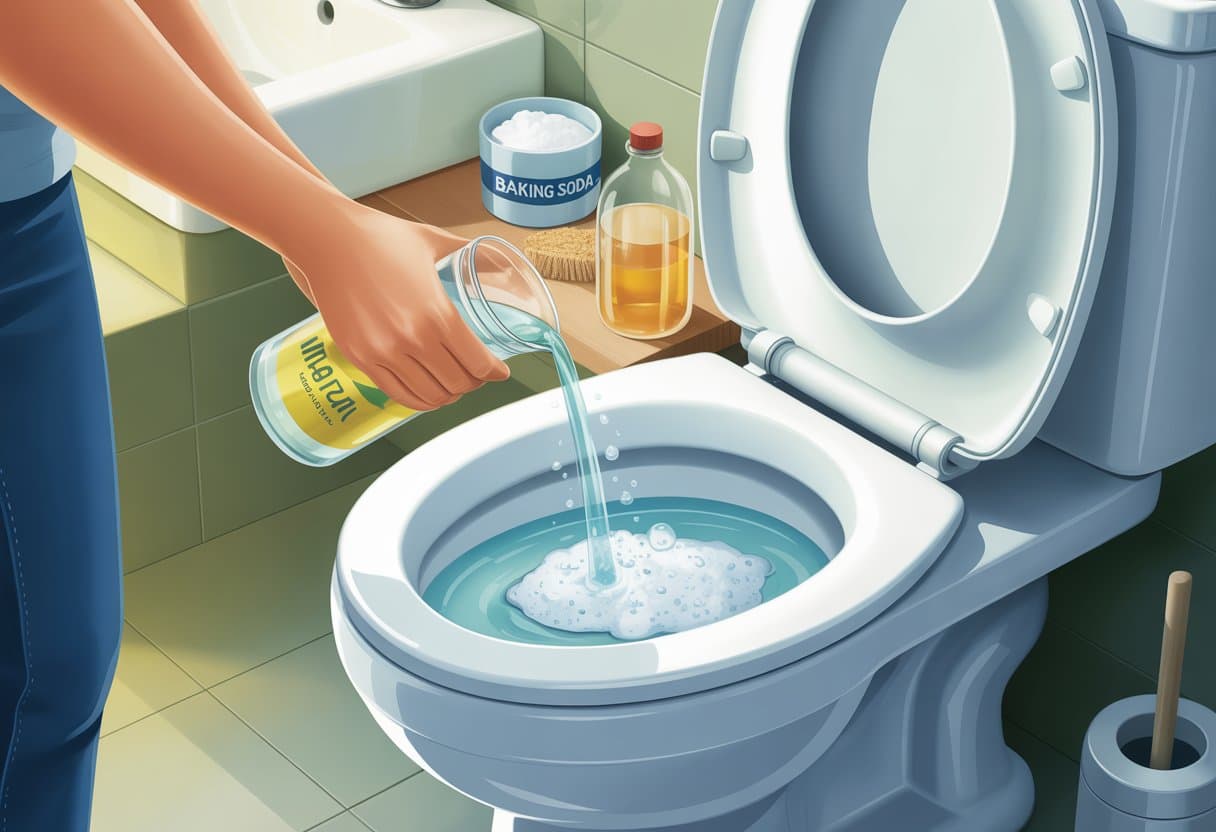A clogged toilet strikes at the worst moments. The water rises. The panic sets in. The plunger is nowhere to be found.
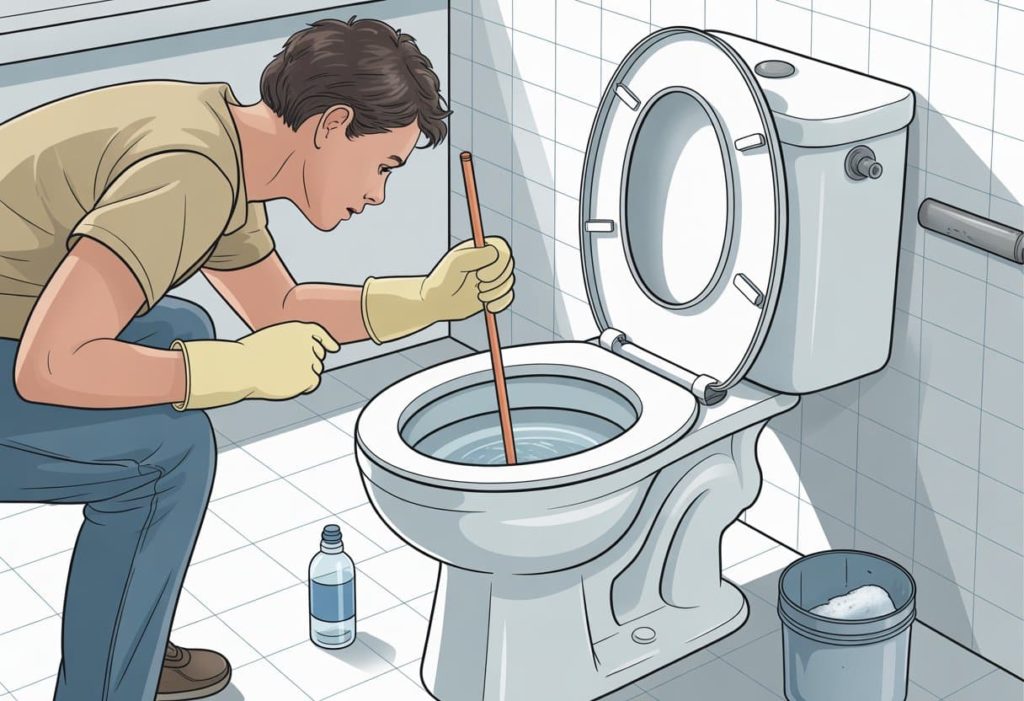
Most toilet clogs can be cleared using simple household items like dish soap, hot water, or baking soda and vinegar. These methods work by breaking down the blockage or creating pressure to push it through the pipes. No special tools required.
The key is staying calm and following the right steps. This guide covers proven techniques that actually work, plus when to stop trying and call for backup. A toilet clog doesn’t have to ruin someone’s day.
Stop The Overflow Before You Start
The toilet bowl keeps rising like a bad horror movie. Time to act fast before disaster strikes.
First priority: Turn off the water supply. Look behind the toilet for a small valve near the wall. Turn it clockwise until it stops completely.
Can’t find the valve? Don’t panic. Remove the toilet tank lid carefully. It’s heavier than it looks and breaks easily.
Inside the tank, find the rubber flapper at the bottom. Push it down firmly against the hole. This stops more water from entering the bowl.
Next step: Locate the float or fill valve mechanism. Push down on the float arm or lift the float ball up. This action stops the tank from refilling.
| Emergency Actions | Where to Find It |
|---|---|
| Shut-off valve | Behind toilet, near wall |
| Flapper | Bottom of tank |
| Float mechanism | Inside tank, connected to fill valve |
Still overflowing? Grab towels and place them around the base. Water damage costs more than a few wet towels.
Pro tip: Keep one hand on the flapper while using the other to adjust the float. This double-action approach works faster than doing steps separately.
The water should stop rising within seconds. Once it’s under control, the real unclogging work can begin safely.
Never skip this step. Even experienced DIYers have learned this lesson the hard way.
Try These Proven Home Methods (No Plunger Required)
These six household techniques use common items to break up clogs and restore toilet function. Each method targets blockages through different actions like heat, soap lubrication, or chemical reactions.
Hot Water Power Flush
Hot water softens waste and toilet paper while creating pressure to push clogs through pipes. The heat breaks down materials that cold water cannot dissolve.
Step-by-step process:
- Boil 1-2 gallons of water in large pots
- Let water cool for 2-3 minutes (not boiling hot)
- Pour from waist height into toilet bowl center
- Wait 10-15 minutes for hot water to work
- Flush toilet to test results
The water temperature should feel very hot but not scalding. Extremely hot water can crack porcelain toilets. Pour steadily but not too fast to avoid overflow.
This method works best on soft clogs made of toilet paper or waste. Hard objects like toys or feminine products need different approaches.
Dish Soap Method
Dish soap acts as a lubricant that helps clogs slide through pipes more easily. The soap reduces friction between waste materials and pipe walls.
Pour 1/2 cup of liquid dish soap directly into the toilet bowl. Any brand works, but thicker soaps like Dawn perform better. Let the soap sit for 20-30 minutes.
Add hot water after the soap has time to coat the clog. Pour 1-2 gallons of hot water from waist height. The combination of hot water and dish soap creates a slippery environment.
Wait another 15 minutes before flushing. The soap continues working during this time. Flush once to see if the clog moves.
This gentle method rarely damages pipes or toilet components. It works well for minor clogs and can be repeated safely.
Baking Soda & Vinegar Reaction
Baking soda and vinegar create a fizzing reaction that breaks up organic matter in clogs. The chemical reaction produces pressure that helps move blockages.
Materials needed:
- 1 cup baking soda
- 2 cups white vinegar
- Hot water
Pour the baking soda into the toilet bowl first. Add vinegar slowly to create maximum fizzing action. The mixture will bubble and foam for several minutes.
Let the baking soda and vinegar work for 30 minutes. Cover the toilet bowl with plastic wrap if possible. This traps gases and increases pressure.
Flush with hot water to push the loosened materials through pipes. The reaction continues working even after the visible bubbling stops.
This natural method is safe for septic systems and won’t harm pipe materials.
Plastic Bottle Pressure Trick
A plastic bottle creates suction and pressure similar to a plunger. This method requires removing water from the toilet bowl first.
Use a large plastic bottle with the bottom cut off. Keep the cap on tight. Wear rubber gloves for this messy job.
Remove excess water from the toilet bowl using a cup or container. Lower water levels give better results. Insert the cut end of the bottle into the drain opening.
Push and pull the bottle rapidly to create pressure changes. The motion forces water back and forth through the clog. Work for 2-3 minutes with quick movements.
Add hot water to test if the clog broke up. This method takes practice but works on many blockages.
DIY Wire Or Coat Hanger Option
A straightened wire hanger can break up clogs manually. This works when other methods fail to reach the blockage.
Straighten a metal coat hanger completely. Wrap one end with a rag or tape to protect porcelain. Create a small hook at the working end.
Insert the wire hanger into the drain opening carefully. Feel around for the clog without scratching the toilet surface. Push and pull gently to break up materials.
Work the wire back and forth to loosen stuck items. Don’t force the wire too hard or it might damage internal toilet parts.
Flush with hot water once the blockage feels loose. Remove the wire slowly to avoid dropping pieces in the toilet.
Safe Use Of Toilet-Specific Cleaners (Optional)
Chemical drain cleaners designed for toilets can dissolve tough clogs. Never mix different drain cleaners together as this creates dangerous gases.
Read labels carefully before using any chemical drain cleaner. Some products damage older pipes or septic systems. Toilet-safe cleaners work differently than sink drain products.
Important safety rules:
- Wear gloves and eye protection
- Ensure good ventilation
- Keep pets and children away
- Never mix with other chemicals
Follow package directions exactly for amounts and timing. Most chemical drain cleaners need 30 minutes to 2 hours to work properly.
Flush with cold water first, then hot water as directed. Chemical drain cleaners should be the last option when other methods fail.
Step-By-Step Troubleshooting Flow
Start with the least messy option first. The hot water method works best for minor clogs.
Check these items before starting:
- Water level in bowl
- Type of blockage visible
- Available household items
Try methods in this exact order:
- Hot water flush – Pour hot water from waist height
- Dish soap method – Add soap, wait 20 minutes, flush
- Wire coat hanger – Straighten and fish out debris
- Baking soda mix – One cup baking soda, one cup vinegar
Each method takes 15-30 minutes to work properly. Don’t rush between steps.
Signs a method is working:
- Water level drops slowly
- Gurgling sounds from drain
- Debris floats to surface
Stop immediately if water rises to rim level. This means the clog got worse.
When to move to next method:
- No change after 30 minutes
- Water stays at same level
- Flush test still fails
The wire hanger method requires gentle movements. Aggressive poking can scratch the toilet bowl.
Final test for each method:
- Wait for water to drain completely
- Add small amount of toilet paper
- Flush with normal water amount
Success means water swirls down quickly without backing up. If all four methods fail, the blockage likely sits deep in the pipes.
When To Call A Professional
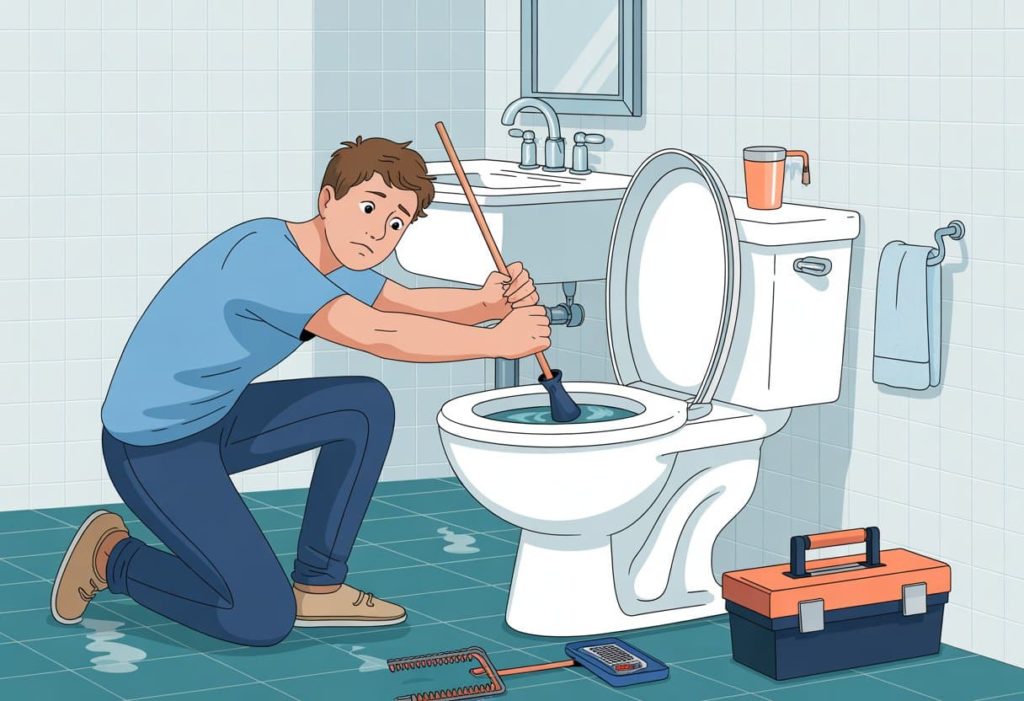
Some toilet clogs fight back harder than a Seattle sports fan defending their team. These stubborn blockages need a professional plumber to win the battle.
Water keeps rising even after trying basic fixes? Stop and step away from the toilet. This means the clog sits deep in the pipes where home tricks can’t reach.
Multiple toilets in the house won’t flush properly. This points to a main sewer line problem that only a plumber can handle safely.
Strange gurgling sounds come from other drains when flushing. The pipes are talking, and they’re saying something is very wrong with the system.
| Call a Professional When: | Why It Matters |
|---|---|
| Water backs up in shower drains | Main line blockage |
| Sewage smell fills the bathroom | Serious pipe damage |
| Toilet rocks or moves | Broken wax ring or flange |
Raw sewage appears anywhere in the home. This creates health risks that require immediate professional attention and proper cleanup.
The toilet itself seems damaged or cracked. A professional plumber can tell if the whole unit needs replacement or just repairs.
Tree roots might be the culprit in older homes. These green invaders love to crash the pipe party, and only special equipment can evict them properly.
Chemical drain cleaners failed to work. Adding more chemicals creates dangerous reactions that can hurt pipes and people.
When the clog keeps coming back every few days, something bigger lurks in the plumbing system that needs expert diagnosis.
How To Prevent Future Toilet Clogs
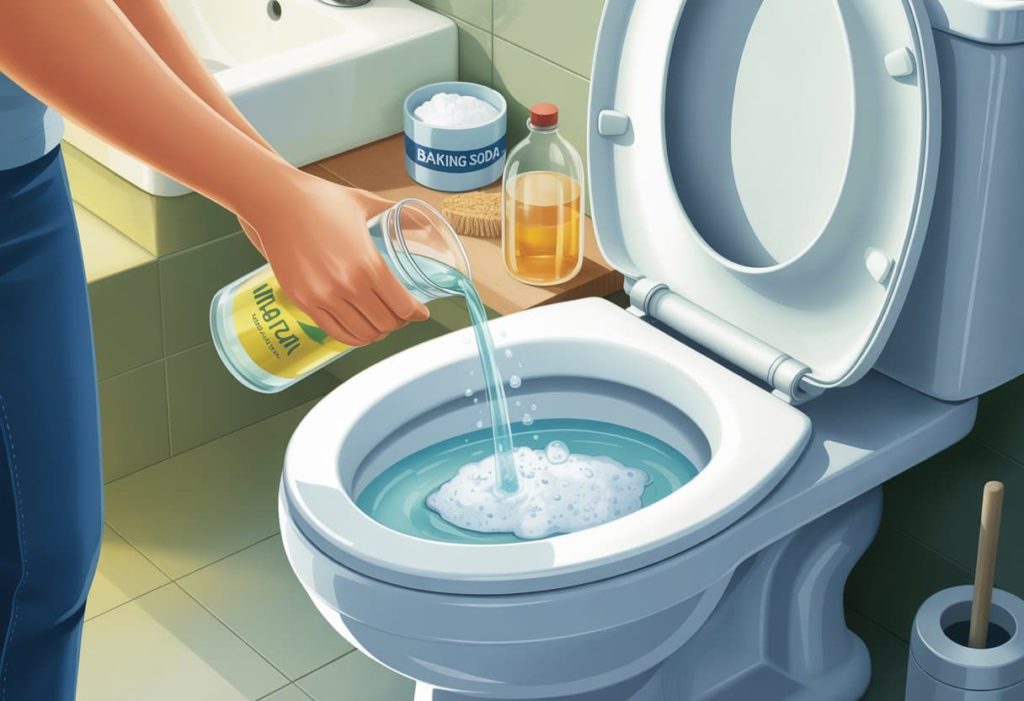
Use less toilet paper. Most people use way more than they need. Three or four squares usually does the job.
Never flush cotton swabs, dental floss, or feminine products. These items don’t break down in water. They create stubborn blockages that require professional help.
Teach kids the toilet rules early. Children love flushing toys, crayons, and snacks down the drain. One goldfish funeral can cost hundreds in repairs.
Watch what goes down during bathroom cleaning. Hair clumps and cleaning wipes cause major problems. Dispose of these items in the trash instead.
| Flush Safe | Never Flush |
|---|---|
| Toilet paper | Baby wipes |
| Human waste | Cat litter |
| Small amounts of vomit | Medication |
Check the toilet tank regularly. A weak flush means clogs happen more often. The water level should reach the marked line inside the tank.
Schedule annual plumbing inspections. A professional can spot problems before they become expensive emergencies. Tree roots and pipe damage cause recurring toilet clogs.
Install a bidet attachment. These devices reduce toilet paper use by up to 80%. Less paper means fewer clogs and lower water bills.
Keep a toilet brush nearby. Quick cleaning prevents buildup that leads to blockages. A clean toilet flushes better than a dirty one.
Final Tips And Wrap-Up
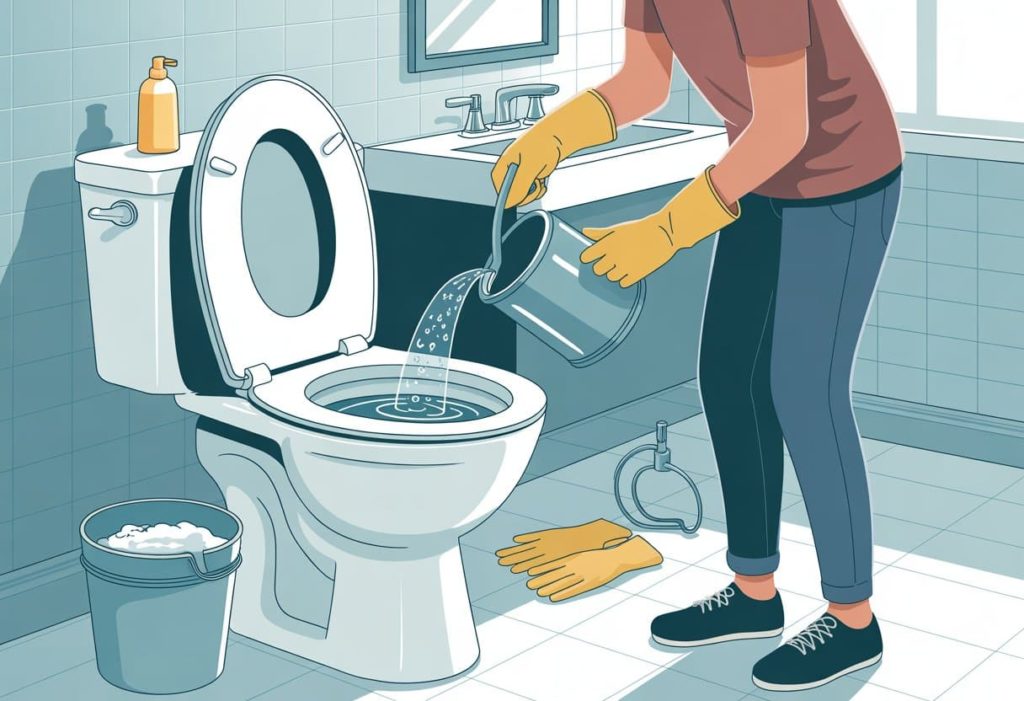
Prevention beats desperation every single time. A toilet brush and regular cleaning keep most clogs from forming.
Keep these items handy for future emergencies:
- Dish soap – Works faster than you’d think
- Rubber gloves – Your hands will thank you
- Bucket – Essential for the hot water method
- Wire coat hanger – Straighten it for tough clogs
Never use chemical drain cleaners in toilets. They can crack porcelain and create toxic fumes. The methods covered here work better anyway.
If water keeps rising after trying these tricks, shut off the toilet’s water supply immediately. The valve sits behind the toilet near the floor.
Most clogs clear within 15 minutes using these techniques. Be patient – rushing leads to messy accidents.
| Method | Time Needed | Success Rate |
|---|---|---|
| Hot water + soap | 10-15 minutes | High |
| Coat hanger | 5-10 minutes | Medium |
| Baking soda + vinegar | 20-30 minutes | Medium |
Call a professional if nothing works after two attempts. Forcing it can damage pipes and cost hundreds in repairs.
Some clogs hide deeper in the system where household methods can’t reach them. Professional plumbers have tools like augers and cameras that solve these stubborn problems quickly.
Pro tip: Test your methods during daylight hours when hardware stores are open. Nobody wants to deal with a clogged toilet at midnight without backup options.
Call To Action: Get Fast, Reliable Help
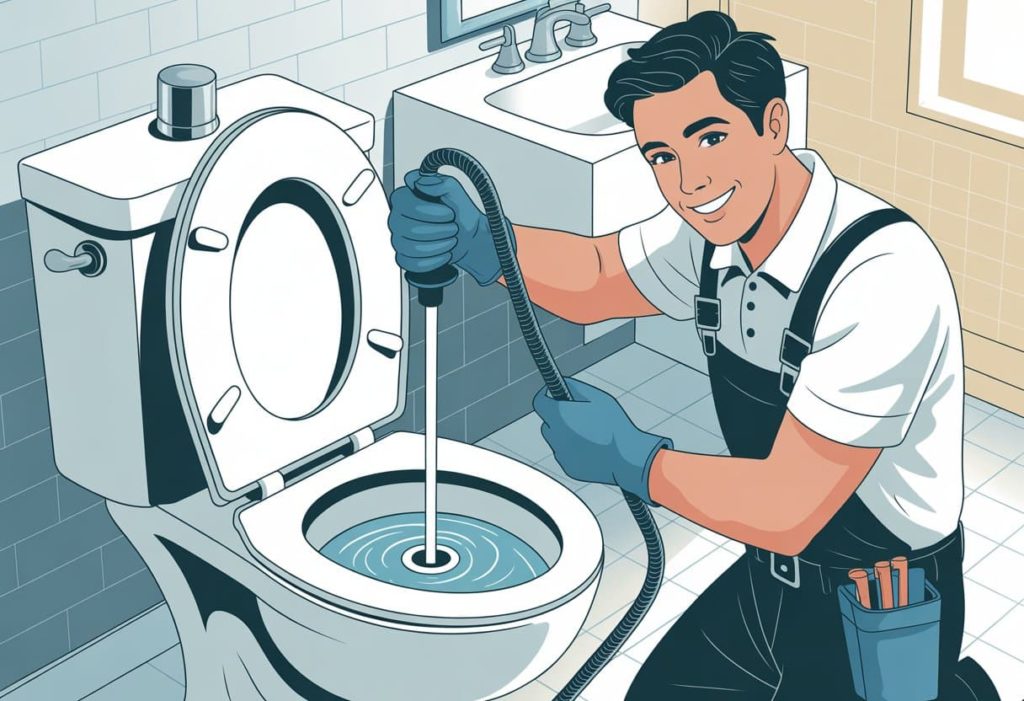
Sometimes a toilet fights back harder than expected. When DIY methods fail, it’s time to call the experts.
Danika Plumbing LLC serves the greater Seattle area with 24/7 emergency service. Our licensed plumbers handle stubborn clogs that laugh at home remedies.
Here’s what makes them different:
- Fast response times – often within 2 hours
- Upfront pricing – no surprise fees
- Modern equipment – professional drain snakes and hydro-jetters
- Clean work – they protect floors and clean up afterward
When to Call Immediately
| Situation | Action Needed |
|---|---|
| Water overflowing | Emergency service |
| Multiple toilets clogged | Main line blockage |
| Sewage smell | Professional inspection |
| Frequent backups | Drain cleaning |
Don’t wait if water keeps rising or won’t go down at all. These signs point to serious blockages that need professional tools.
Danika’s team works throughout Everett, Seattle, Bellevue, and surrounding areas. They’ve seen every type of clog imaginable – from toy trucks to entire rolls of toilet paper.
Call (425) 374-1557 for same-day service. Their plumbers arrive with fully stocked trucks and solve most problems on the first visit.
Why struggle with a stubborn toilet when help is one phone call away? Professional plumbers save time, prevent damage, and get bathrooms back to normal fast.
Frequently Asked Questions

People often wonder about the best ways to clear toilet clogs without traditional tools. These solutions use common household items and basic plumbing techniques.
What alternatives can I use to unclog a toilet if I don’t have a plunger?
Hot water and dish soap work well for many clogs. The person should pour a cup of dish soap into the toilet bowl. Then they add hot water from waist height.
A wire coat hanger can also help. They should straighten it and create a small hook at one end. The hook can break up clogs or pull out debris.
Baking soda and vinegar create a fizzing action. One cup of baking soda followed by two cups of vinegar often loosens minor blockages.
Can a toilet auger effectively clear a stubborn clog in the toilet?
A toilet auger works better than most other tools for tough clogs. This specialized tool reaches deeper into the toilet drain than household items.
The auger has a long cable that rotates to break through blockages. Most hardware stores sell toilet augers for under fifty dollars. They work on clogs that dish soap and hot water cannot clear.
A toilet auger is gentler on porcelain than a regular plumbing snake. The tool has a protective sleeve that prevents scratches.
What are the best methods to unclog a toilet quickly and efficiently?
Hot water and dish soap clear most clogs within thirty minutes. The person should let the mixture sit before flushing.
A toilet auger handles stubborn blockages faster than homemade solutions. The tool usually clears clogs in five to ten minutes.
Enzyme cleaners work overnight for organic waste clogs. These products break down waste naturally without harsh chemicals.
Are there any DIY solutions for unclogging a toilet filled with waste and water?
The person should remove excess water first using a bucket or cup. This prevents overflow during the unclogging process.
Hot water and dish soap work even with waste present. The soap helps break down organic matter while hot water softens the clog.
A toilet brush can help break up soft waste clogs. They should use firm pressure and a pumping motion. This method works when waste causes the blockage.
What household items can help in unclogging a toilet without professional help?
Dish soap creates slippery conditions that help waste slide through pipes. Any liquid dish soap works for this method.
A wire coat hanger becomes a makeshift drain snake. The person should wrap the end with a rag to protect the porcelain.
Plastic bottles can create suction similar to a plunger. They should remove the cap and squeeze the bottle while it sits in the drain opening.
Hot water from the sink adds pressure to help push clogs through. The person should pour from waist height for best results.
How can I safely unclog a toilet when the water level is already high?
The person should turn off the water supply valve behind the toilet first. This prevents additional water from entering the bowl.
They can remove water using a bucket or large cup. Old towels should be placed around the toilet base to catch spills.
A plumbing snake or toilet auger works well with high water levels. These tools can reach the clog without adding more liquid to the bowl.
The person should never use chemical drain cleaners in standing water. These products can splash and cause burns.
